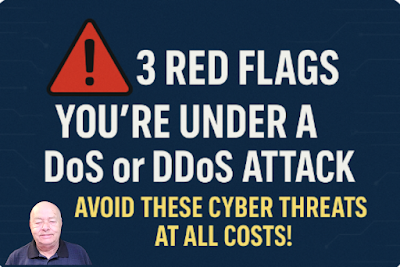3 Red Flags You're Under a DoS or DDoS Attack (and What You Can Do About It)
If you prefer, you can also listen to this information on my Podcast at: https://creators.spotify.com/pod/show/norbert-gostischa/episodes/3-Red-Flags-Youre-Under-a-DoS-or-DDoS-Attack-and-What-You-Can-Do-About-It-e32c24t
Imagine this - You’re all set to launch your new product or run a weekend flash sale… and suddenly your website is slower than a snail sipping molasses. Visitors can't load pages, customers can't check out, and your support inbox is on fire. What happened?
You, my friend, may be the latest victim of a DoS (Denial of Service) or DDoS (Distributed Denial of Service) attack.
In simple terms, a DoS or DDoS attack is when cybercriminals flood your site or service with so much junk traffic that it becomes overwhelmed, overloaded, and essentially knocked offline—like a digital stampede.
Here are the top 3 red flags to watch out for so you can spot the chaos before it turns into a full-blown cyber disaster.
🚩Red Flag #1 - Your Website Is Sluggish or Totally Unreachable
We’re talking loading times that make dial-up look fast.
Pages don’t load, Checkout forms time out, The whole site might crash altogether.
If your website is suddenly acting like it’s stuck in digital quicksand, and there’s no logical explanation (like a huge spike in real users or a tech update gone wrong), it’s time to raise your eyebrows.
💡Why This Matters:
This isn’t just a nuisance - For businesses, downtime equals lost sales, lost trust, and a PR headache. Even short DDoS attacks can cost thousands per minute. And for non-commercial sites, it's still damaging—no one wants their blog, forum, or nonprofit site knocked offline.
🚩Red Flag #2 - A Surge in Strange Traffic From Unusual Places
Let’s say you usually get 100 visitors a day from the U.S. and suddenly, you're hit with 50,000 "visitors" from random countries where you don’t even operate. Congratulations! You may have just been botnet-blitzed.
Traffic skyrockets with no marketing reason behind it.
You spot repeated visits from unfamiliar or suspicious IP addresses.
Most of the traffic hits the same URL or page.
This kind of pattern suggests a DDoS attack. These attackers often use botnets—a zombie army of hacked devices (think fridges, baby monitors, and hacked routers!)—to flood your servers. It’s like a crowd of fake customers all shouting “I NEED HELP!” at once… and none of them really mean it.
💡Why This Matters:
DDoS traffic isn’t just annoying—it’s deliberate. These fake requests clog the line for real users, crash your systems, and sometimes even hide a more serious attack going on in the background.
🚩Red Flag #3 - Server Logs That Look Like a Glitch in the Matrix
If you peek under the hood (aka your security logs) and see:
A spike in 503 or 504 errors, Requests hammering the same resource, Odd user-agent strings or malformed packets, then something’s fishy. Attackers often use DDoS tactics to repeatedly target weak spots in your app or server configuration.
💡Why This Matters:
These logs are your early warning system. They can reveal if you’re being targeted, when the attack started, and how sophisticated it might be.
🧠Bonus Alert - The Rise of IoT Botnets
Back in the day, DDoS attacks were launched from infected PCs. Now? They’re powered by everything but the kitchen sink—though that may be coming soon.
Hackers love unsecured smart devices (IoT). Everything from light bulbs to webcams can be hijacked and turned into a DDoS foot soldier. The 2025 trend? Bigger botnets, faster attacks, and more creative chaos. According to recent cybersecurity insights, DDoS volumes are scaling dramatically, with some attacks peaking over 2.5 terabits per second. That’s like trying to drink from Niagara Falls using a straw.
🔐What You Can Do to Protect Yourself
Now that you know the warning signs, here’s how to be proactive:
🛡1 - Use a DDoS Mitigation Service - Providers like Cloudflare, Akamai, or AWS Shield can detect and block malicious traffic before it hits your site.
🧭2 - Monitor Website Traffic Regularly - Set up alerts for unusual traffic patterns, failed requests, or location-based anomalies. The earlier you spot something off, the faster you can act.
🔒3 - Harden Your Infrastructure - Update your software. Secure your IoT devices. Limit requests per IP. Use a Web Application Firewall (WAF) to block common attack methods.
🧼4 - Have a Response Plan - If you do get hit, you don’t want to be Googling “What is DDoS?” in a panic. Have a step-by-step plan in place to isolate, mitigate, and recover.
🎯Bottom Line - DoS and DDoS attacks aren’t just geeky hacker pranks—they’re real, disruptive, and increasingly sophisticated. Whether you’re running a business, blog, or just want to keep your online presence stable, being able to spot the red flags early can save you a world of headaches.
So the next time your website’s acting strange, don’t just reboot your router and hope for the best. Take a closer look.
Stay safe, stay secure and realize that this slowdown might just be the digital equivalent of someone banging on your door with a battering ram.
(AI was used to aid in the creation of this article.)
"I'll see you again soon. Bye-bye and thanks for reading, watching, and listening."

.png)
Comments